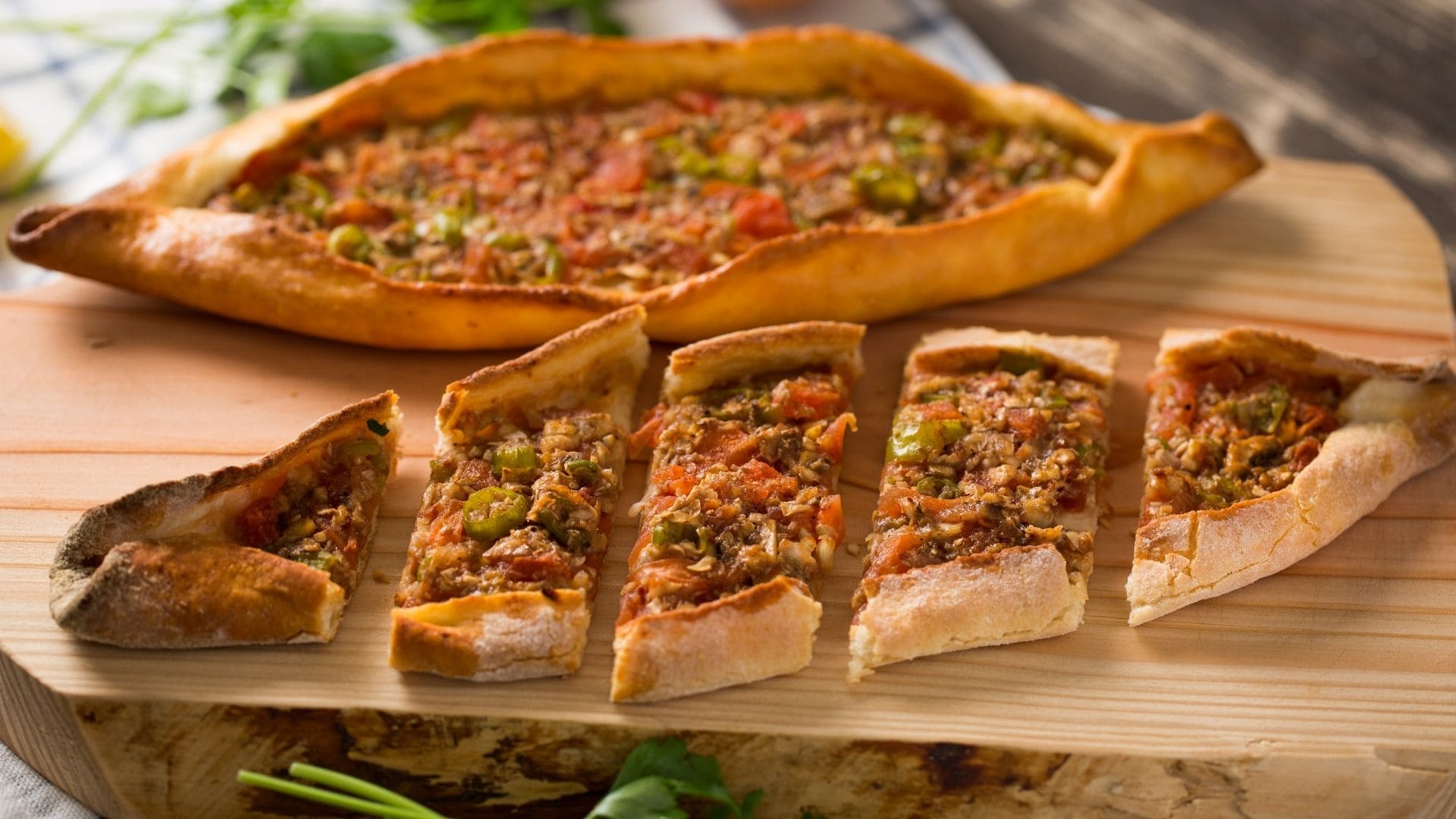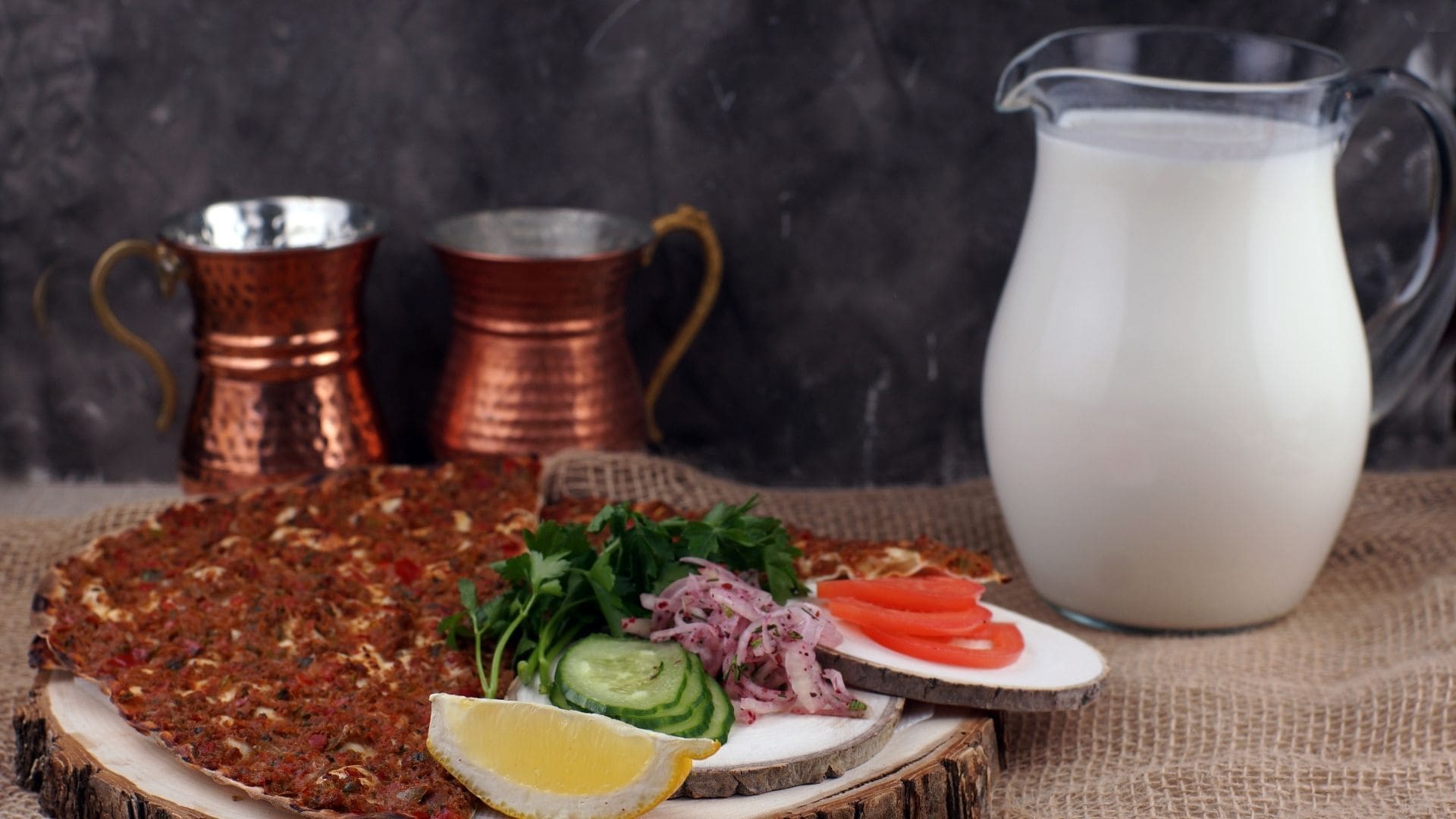Turkish cuisine is renowned for its rich, diverse flavors and traditional dishes. Among the most beloved staples are pide and lahmacun, often referred to as Turkish pizza. These iconic dishes have deep-rooted histories and play significant roles in Turkish culinary culture.
Blog Contents
ToggleA Look at the History of Pide and Lahmacun
Pide and lahmacun are integral parts of Turkish gastronomy, each with a unique history.
Pide: Often called Turkish flatbread, pide dates back to the time of the Ottoman Empire. This boat-shaped bread is typically topped with various ingredients such as cheese, meats, and vegetables. The dough is soft and slightly crispy on the edges, offering a delightful contrast in textures. The origins of pide are somewhat nebulous, but it is believed to have been influenced by various Middle Eastern and Mediterranean flatbreads.
Lahmacun: Lahmacun, on the other hand, is a thin, round dough topped with a mixture of minced meat, vegetables, and herbs. Its origins can be traced back to the Levant region. The name “lahmacun” is derived from the Arabic “lahm bi’ajeen,” meaning “meat with dough.” Historically, it was a popular street food, beloved for its portability and satisfying flavor.

The Place of Pide and Lahmacun in Turkish Cuisine
Pide and lahmacun hold significant places in Turkish cuisine, serving as both everyday meals and special treats.
Pide: Pide is often enjoyed during special occasions such as Ramadan, where it is a staple for the iftar meal. Its versatility makes it suitable for any meal of the day, from breakfast to dinner. Common varieties include:
- Kuşbaşılı Pide: Topped with small cubes of seasoned meat.
- Kaşarlı Pide: Covered with melted cheese, often with an egg cracked on top.
- Sebzeli Pide: A vegetarian option loaded with fresh vegetables.
Lahmacun: Lahmacun is often considered a street food but is also enjoyed at home and in restaurants. It is typically served with fresh vegetables and herbs like parsley, onions, and tomatoes, along with a squeeze of lemon juice. This combination enhances the flavors and provides a refreshing balance to the spiced meat topping.
Pide and Lahmacun Varieties
Both pide and lahmacun come in numerous varieties, each with its unique twist on the traditional recipe.
Pide Varieties:
- Karadeniz Pidesi: Originating from the Black Sea region, it often includes butter and an egg, making it rich and flavorful.
- Lahmacun Pidesi: Combining the best of both worlds, this variant includes the minced meat topping of lahmacun but with the thick, fluffy dough of pide.
Lahmacun Varieties:
- Traditional Lahmacun: Features a simple topping of minced meat, onions, tomatoes, and spices.
- Spicy Lahmacun: For those who prefer a bit more heat, this variant includes extra chili peppers.
- Vegetarian Lahmacun: A modern twist, substituting the meat with a blend of spiced vegetables.
The Art of Cooking Pide and Lahmacun
The preparation of pide and lahmacun is an art that requires skill and tradition.
Making Pide:
- Dough Preparation: The dough is kneaded until it reaches the perfect consistency, then left to rise.
- Shaping: The dough is shaped into its distinctive boat shape.
- Topping: Various ingredients like cheese, meats, and vegetables are added.
- Baking: The pide is baked in a traditional stone oven, which gives it a unique texture and flavor.
Making Lahmacun:
- Dough Preparation: Similar to pide, the dough is prepared and rolled out into thin circles.
- Topping Mixture: The topping, made from minced meat, tomatoes, onions, and spices, is spread evenly over the dough.
- Baking: Baked at a high temperature until crispy, ensuring the toppings are cooked through and flavorful.
Appetizers, Salads, and Drinks Complementing Pide and Lahmacun
A meal of pide or lahmacun is best enjoyed with a selection of appetizers, salads, and traditional drinks.
Appetizers:
- Hummus: A creamy blend of chickpeas, tahini, lemon juice, and garlic.
- Dolma: Grape leaves stuffed with rice, pine nuts, and herbs.
- Cacık: A refreshing yogurt and cucumber dip, seasoned with garlic and dill.
Salads:
- Çoban Salatası (Shepherd’s Salad): A mix of tomatoes, cucumbers, onions, and green peppers, dressed with olive oil and lemon juice.
- Gavurdağı Salatası: A hearty salad with tomatoes, walnuts, pomegranate molasses, and fresh herbs.
Drinks:
- Ayran: A traditional yogurt-based drink, salty and refreshing.
- Turkish Tea: Strong black tea served in small glasses.
- Şalgam: A tangy, fermented carrot juice, often paired with spicy dishes.
Mama Fatma Restaurant Pide and Lahmacun Selections
At Mama Fatma Restaurant in Toronto, Ontario, Canada, we pride ourselves on offering an authentic taste of Turkish cuisine. Our menu features a variety of pide and lahmacun, prepared with the finest ingredients and traditional methods.
Pide Selections:
- Classic Cheese Pide: Melted cheese with a hint of butter.
- Spicy Meat Pide: Seasoned minced meat with a kick of spice.
- Vegetarian Pide: Loaded with fresh vegetables and herbs.
Lahmacun Selections:
- Traditional Lahmacun: Minced meat with a blend of spices and herbs.
- Spicy Lahmacun: Extra chili for those who love heat.
- Vegetarian Lahmacun: A flavorful mix of spiced vegetables.
At Mama Fatma, we also offer a range of appetizers, salads, and drinks to complement your meal. Whether you’re dining in or looking for “lahmacun near me” for a quick takeaway, our restaurant is the perfect place to experience the best of Turkish pide and lahmacun.

Pide and lahmacun are more than just dishes; they are a piece of Turkish tradition and culture. Their rich history, variety, and delicious flavors make them beloved staples in Turkish cuisine. At Mama Fatma Restaurant in Toronto, Ontario, Canada, we invite you to experience these traditional delights, crafted with love and authenticity. Whether you’re a local or visiting, our selection of pide and lahmacun will transport you to the heart of Turkey with every bite.
By incorporating these traditional dishes into your culinary repertoire, you not only enjoy a taste of Turkey but also keep a piece of its history alive. So, come and indulge in the rich, diverse flavors of Turkish cuisine at Mama Fatma, where every meal is a journey through time and tradition.

Turkish Sauces and What They’re Used For
In the world of Turkish cuisine, sauces are rarely just simple condiments; they are functional, flavor-enhancing masterpieces. Unlike the ubiquitous ketchup or mayonnaise found elsewhere, Turkish sauces—or more accurately, dips

How to Order Turkish Food for the First Time: A Stress-Free Guide
Trying a new cuisine is an adventure—a mix of excitement and maybe a little nervousness when looking at an unfamiliar menu. You want to order something delicious, authentic, and something

Why Turkish Dining Is Ideal For Slow Evenings
In the constant rush of life in Toronto, Ontario, the evening often feels like another race against the clock. We eat quickly, distracted, and often leave the table feeling full

How Turkish Cuisine Connects Cultures
Food is perhaps the most universal language we share. It requires no translation, crosses every border, and speaks directly to memory and comfort. And among the world’s great traditions, Turkish

What Makes Turkish Pide Fillings So Creative
When you think of flatbreads with toppings, you probably think of pizza. But in Turkey, there is a culinary masterpiece that takes the concept of a savory filling to a

How To Order Turkish Food For Large Groups
Planning a dinner for a large group—a corporate event, a big family reunion, or a celebration with friends—can feel like navigating a culinary minefield. Everyone has different preferences, and the





